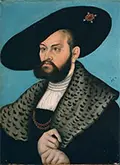Albert I: Duke of Prussia
Albert I was the first Duke of Prussia, reigning in that capacity for more than four decades in the 15th Century. 
He was born on May 17, 1490, in Ansbach, in Franconia. His father was Margrave Frederick I of Brandenburg-Ansbach, and his mother was Sophia of Poland. Albert was his parents' third son and, as was the tradition, embarked on a study of religious matters, to prepare for a career in the clergy. He embraced this learning and served as canon of the Cologne Cathedral. Albert also had an interest in mathematics and science and saw contradictions in the facts and figures of those pursuits and the faith and beliefs of his religious training. He wanted to learn more about the world around him and so went with the Holy Roman Emperor Maxilimian I to Italy in 1508. Thee years later, Albert found himself chosen to be the new Grand Master of the Teutonic Order, a military organization that had been at odds with the nearby Prussian tribes for many years. He was unsuccessful in preventing another conflict, and the result was devastation in Prussia. Seeking to find some end to the fighting, he went to Nuremberg to appeal to the new Holy Roman Emperor, Charles V. He had no luck there and then traveled to Wittenberg, where he met the soon-to-be-famous monk Martin Luther, who advised Albert to leave the Catholic faith and become a Protestant, someone like Luther who rejected many of the Church's teachings. Further, Luther urged Albert to make Prussia a hereditary duchy and rule it himself. He did so, proclaiming the new Duchy of Prussia on Feb. 10, 1525. The response within the empire was mixed and varied. Other German states at this time were consumed with the Reformation, led in party by Luther, and with uprisings by peasants. Prussia enjoyed a relatively successful start as a duchy. Support for Luther and the promotion of his ideas gave Albert and his duchy many friends; at times, money flowed into Prussian coffers. Fully renounced as a clergyman, Albert got married, to Dorothea of Denmark, in 1526. They had six children, one of whom lived in adulthood: Anna Sophia (1527). Dorothea died in 1547. Albert married Anna Maria of Brunswick-Lüneburg in 1550; they had two children, both of whom lived into adulthood: Elisabeth (1551) and Albert Frederick (1553). Turbulence and tumult were increasingly normal states of affair in the Middle Ages, as religious conflicts turned into policial ones. Still deadly as well were many diseases, including the plague. It was that that killed Albert and his second wife, Anna Maria, on March 20, 1568. They died at Tapiau Castle. Their son, all of 15, was the next Duke of Prussia. |
|
Social Studies for Kids
copyright 2002–2024
David White





